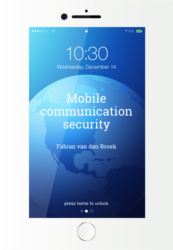Mobile Communication Security
Fabian van den Broek
promotor: prof.dr. B.P.F. Jacobs (RU)
copromotor: dr.ir. E. Poll (RU)
Radboud University Nijmegen
Date: 14 December, 2016
Thesis: PDF
Summary
This thesis examines the security of mobile communication technology, with a theoretical and practical perspective. Specifically it examines the wireless interface between cell tower and mobile phone for GSM and its successors (GPRS, UMTS and LTE). In GSM the wireless interface can be eavesdropped with relative ease, making it an unsuitable technology for sensitive information. While such eavesdropping is much harder on GSM’s successors, it turns out that all current mobile communication technology still has potential weaknesses. In practice though, these weaknesses are often hard to exploit without expensive equipment or specific knowledge and skills. Besides, a lot of these potential weaknesses are dependent on provider specific settings, which makes it hard to make generic statements on the security of the mobile network. In practice we do see a clear trend of moving to more secure settings (such as the use of strong encryption algorithms).
While we first examined the security of the wireless interface, we later also looked at the end-points of this interface: the mobile phone and the cell tower. For mobile phones we looked at the quality of the software that processes the mobile signals. Through a testing technique known as “fuzzing” (essentially automated, random testing) we can quickly find a large number of bugs. These bugs prove to be surprisingly divers; software of the same vendor on different devices reveals different mistakes. Since we did this research, at least one major vendor of this type of software rewrote its entire software stack to remove most buggy behaviour.
Normally it is hard for an attacker to obtain prolonged physical access to the other end-point of the wireless connection, cell towers. This changes with the introduction of so-called “femtocells”, cheap low-powered cell towers for consumers, providing attackers with easier access to a provider’s core network. To prevent an attacker from doing too much damage once he gains full control of a femtocell, providers should place as little trust as possible in these devices, by treating them essentially as a relay to an actual cell tower and never sending them any confidential information. Still, even a low-trust femtocell introduces security risks for the mobile network, as they offer attackers a cheap device which can handle a lot of the mobile phone protocols.
Mobile phones are often used as a second factor in authentication. During authentication users then prove that they still have control over their mobile phone. This can be a cheap way to quickly increase the security of a system. However, for high-security services it is not sufficient to only trust in the security offered by the mobile network, as happens with the use of transaction numbers sent over SMS.
Where most of this thesis covers different security analyses, the final part introduces an improvement to mobile networks which significantly increases their security, while requiring only minimal changes. This improvement makes it impossible to track a user’s location based on his permanent identity in the mobile network, by replacing the permanent identities with temporary identities, which get renewed in secret. A side effect of this process allows GSM phones to verify whether they are communicating with an authentic cell tower, thereby fixing the biggest security flaw in GSM. This improvement can be introduced by individual providers without the rest of the network needing any changes or even noticing the change. We are currently working with the GSM Association (GSMA) to get this improvement into the mobile specifications.